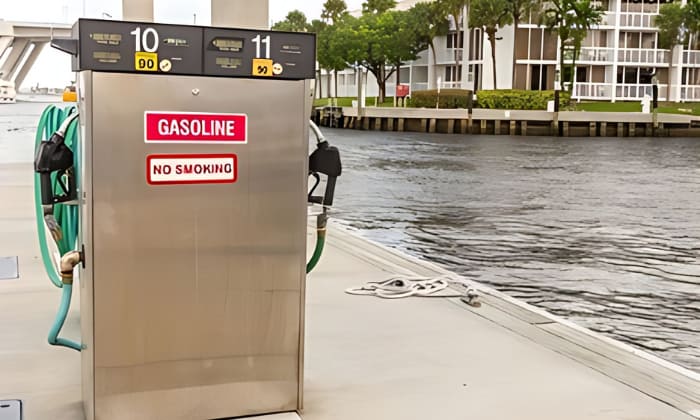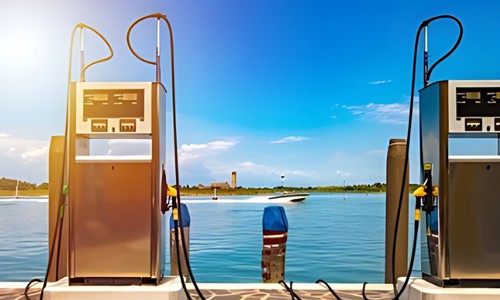What should you do when fueling an outboard boat with a portable tank? Ensuring safety for everyone, including yourself, is your primary concern.
From preparing the tank to refilling it with fuel, boaters must observe standard safety procedures to minimize the risk of fuel-related incidents, such as removing all flammable items and handling the gas away from the boat.
After all, nobody wants an otherwise pleasant boating trip to turn into a nightmare.
But how do you ensure safety when refilling a diesel or gasoline powered boat? Read on.
Table of Contents
Safety Precautions
Refueling safety starts long before you insert the gas nozzle into the portable tank’s opening and squeeze the lever. It begins right on the water when you first notice you’ve run out of fuel.
Here are the safety precautions that can save your life and others when refueling.
- Disconnect portable gasoline fuel tanks from their assemblies and bring them to the shore to refill. Please DO NOT refuel in the boat because inadequate ventilation, the presence of flammable materials, and the risk of spills are serious safety hazards.
- Secure non-essential passengers by letting them stay in the boat while you refill the portable tank on the shore. Alternatively, you can let them stay somewhere far from the refueling area.
- Avoid introducing heat into the refueling process. Don’t smoke or use electronic devices and other gadgets that could create electrical arcs.
- Ensure the portable fuel tank is free of dirt and debris before refilling.
- Inspect the fuel lines and the tank for signs of leaks. You must delay the refilling process until you address the leaky issues.
- Lay an absorbent cloth on the ground to catch any fuel drips.
Safe Fueling Procedures With Portable Tanks
Here are the steps for a safe refueling practice, allowing you to return to your boating adventures without any unnecessary incidents.
- If this is your first time refilling a portable fuel tank, we recommend examining the setup to determine how to remove it properly from the boat. An owner’s manual and a few hand tools can come in handy.
- Bring the portable fuel tank to the boat gas station or anywhere you can refill it with fuel.
- Place the portable fuel tank on a flat and level pavement to prevent accidental tipping. Please avoid refueling the tank on your truck’s bed because static sparks could occur.
- Place a filtered funnel into the portable fuel tank’s opening. This device is better than non-filtered funnels because it prevents unwanted particles from entering the tank.
- Insert the fuel pump nozzle into the portable fuel tank’s filler cap to prevent static sparks.
- Refill the tank without filling it to the brim. About 90% full should be sufficient. This important step in the fueling process is crucial in reducing the risk of accidental boat fires, as gas can expand.
- Bring the portable fuel tank back to the boat. You might want to request assistance because it is heavier now than before refueling.
- Secure the portable tank to its base on the boat and reattach the fuel line.
So, when should the blower be operated? Experts recommend turning on the ventilation blower right after “refueling” to help remove flammable gases in the boat’s hull or cabin. Boaters must also wait at least four minutes before turning on the engine.
Tips for Fueling Based on Location and Vessel
Refueling a portable tank is easy. And if you have a tank mated to your boat, you can still observe the same safety precautions and pointers during refueling, with a few additional tips.
1. Fueling at Fuel Dock
-
- Slowly maneuver your watercraft to the fuel dock and secure it in place.
- Always switch off the boat’s engine when refueling.
- Ask passengers to disembark during refueling. They must stay a safe distance from the fueling dock.
- Inspect the boat, dock, and surroundings for potential fire hazards.
- Ensure all boat openings (i.e., windows, ports, doors, etc.) are closed.
- Turn on the ventilation blower for at least four minutes and perform a sniff test before switching the engine ON.
2. Fueling at Gas Station
-
- Ask the gas station attendant what fuel type they have. Some providers offer gasoline blended with ethanol. Make sure the ethanol doesn’t exceed 10%, as too much of this chemical may harm the tank and invalidate your engine warranty.
- Keep your boat as level and stable as possible on the trailer. You might want to adjust the trailer elements (i.e., hitch, rollers, and bunks) to ensure more efficient refueling and without spilling fuel in the boat.
- Stand on a step stool or get on the boat when refueling at the gas station. You will want an unobstructed look into the deck fill. Moreover, you’ll feel more comfortable with the nozzle near your center of gravity.
3. Fueling PWCs
-
- The issue with PWC fuel tanks is that they sit near the waterline. Please pick a fuel dock with a mechanism for securing and stabilizing PWCs.
- Alternatively, anti-wave barriers surrounding the fuel dock should prevent waves from reaching the PWC during refueling and causing instability that reduces in drips.
- Secure your PWC before refueling using dock lines and fenders.
- Cover the deckfill’s surroundings with oil-only absorbent pads to prevent errant fuel drops from getting into the water. You can also wrap the same material around the fuel pump nozzle.
Conclusion
What should you do when fueling an outboard boat with a portable tank? Simple! Think safety. If you can put safety above all else, refueling a removable or fixed fuel tank should be a cinch.
Like automobile owners, boaters must recognize the flammable nature of fuel. Nobody wants to turn a watercraft into a fiery inferno in the water or at the dock, or worse, you might harm passengers and other boaters.

Ten years of enjoying countless trips on boats never made me love them any less! So I am here to put all those experiences into good use for other boaters who want to have a safe and fun trip with their friends and families.







